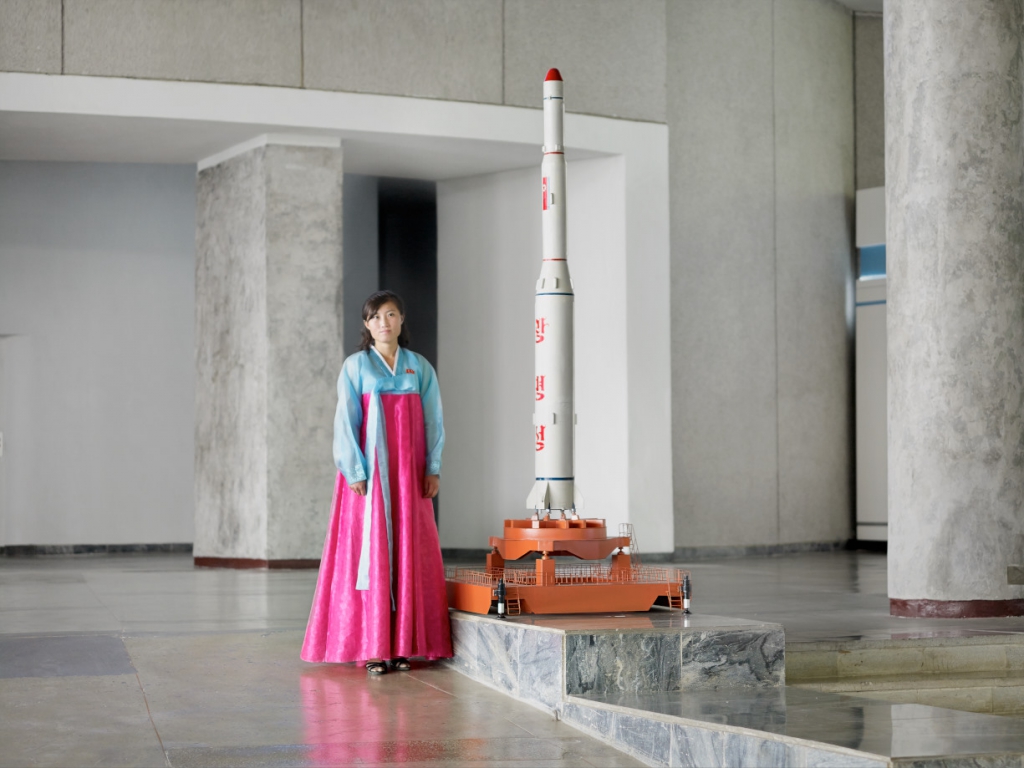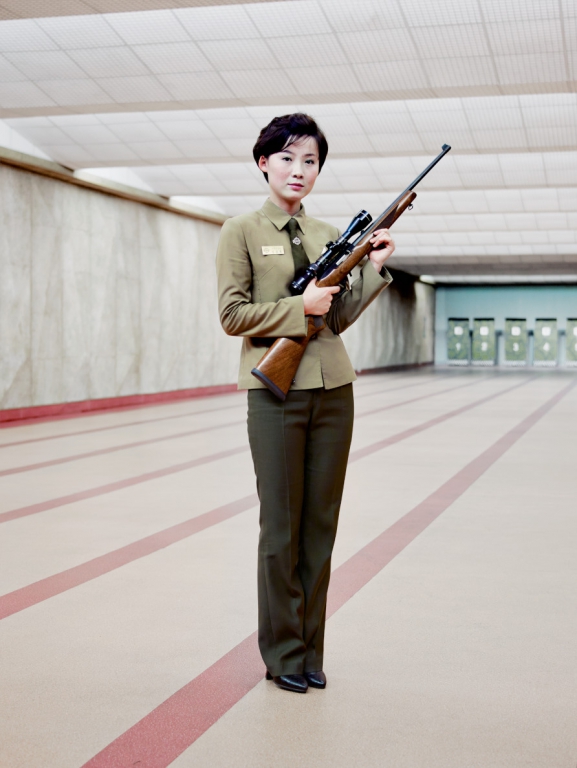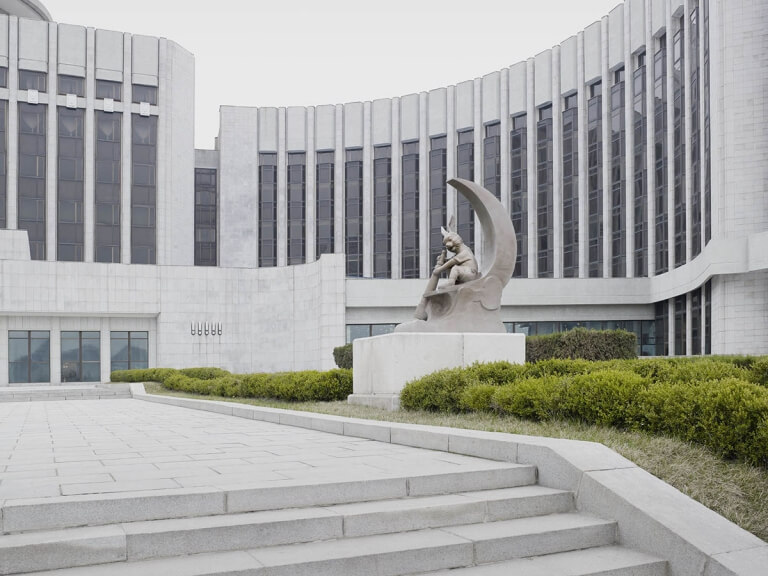In Eddo Hartmann / Setting the Stage: Pyongyang, North Korea the photographer Eddo Hartmann (1973, The Hague) shares his first look at the North Korean capital. Hartmann, who was on the long list for the Prix Pictet (2012) and the Dutch Doc Award (2013), spent several years preparing for this new project. Although he is not the only Western photographer to have chose North Korea as his subject, his work differs from theirs in that he focuses exclusively on the city’s architectural aesthetic. His images of this urban landscape put one in mind of a décor; a theatrical backdrop to public life under North Korean Socialism. The exhibition ‘Setting the Stage: Pyongyang, North Korea’ is a viewing of Hartmann’s first acquaintance with the North Korean model city of Pyongyang, and is the first episode in this ongoing photographic project. In the run-up to the exhibition opening, Huis Marseille’s assistant curator Anna Kruyswijk talked with Eddo Hartmann about the attraction of Pyongyang and the role this photo series plays for him.
Anna Kruyswijk: Why did you choose North Korea as a subject?
Eddo Hartmann: After my last project ‘Hier woont mijn huis’ (‘My house lives here’), which was very personal, I felt a strong need to get away from my own inner world and look at something completely different, something a long way away from my own life. But another reason for the choice was that I’ve always been interested in the kind of spaces, locations and landscapes that have a story to tell about what happened there. I try to interpret those stories by making photographs of those places.
And I’ve been interested in Korea for a long time. I read a lot about history, especially about the Cold War, whose aftermath is very visible in North Korea. And the country also has a certain mystique. We hear a lot about it in the media, but at the same time we know very little about it. I realized that I was keen to go there as a photographer and see it for myself. I knew that because this was North Korea, ‘seeing’ would mean literally seeing only a very small part of the whole – but that was the plan, anyway. I wanted to read the city in order to learn about the people, and I hoped that this would be possible.
AK: So that ‘very small part’ promised much more than we can know about North Korea from our armchairs?
EH: That’s hard for me to tell. But I would say that as a photographer I’m providing something else. I approached this project specifically as a photographer rather than as a tourist. When you make it clear that you’re a photographer, people want to show you certain things, and they try not to show you others, which says a lot in itself.
AK: How did you get permission to take photographs?
EH: Good question. I knew I was dealing with an extremely closed country, and that I wouldn’t be able to do this project on my own. So, after looking around for a long time, I got in touch with some people who had already made documentaries and films, and I proposed that we work together, so that they shared their North Korean know-how with me. In the end I launched the project with the Koryo Studio documentary makers, and that’s how I was able to take photos there.
AK: Could you say a bit more about how the process went, from the first idea, years ago, up to this interview right before the exhibition opens?
EH: I started talking to people about my interest in North Korea. I soon saw that that the capital was a really interesting place, because the images of it were so abstract. I couldn’t even imagine what being there would be like; they looked like photographs out of another age. Then I thought up a plan around what I thought would be possible in practice, and once I found a project partner I worked that up in more detail.
Actually I’m still in the middle of that process, and in this exhibition I’m sharing the the first part.
AK: If we now zoom in on the photographs themselves, we see the elements of which Pyongyang’s urban image is constructed. What is it, in your view, that makes the architecture in this city so impressive?
EH: What made the deepest impression on me was realizing that everything there was built with a political idea in mind. Every single building belongs to the state and is run by the state – from children’s schools to study areas and workplaces. The leaders play the principal roles in public life, and this is reinforced by loudspeakers, placed all over the city, that broadcast messages from the Workers’ Party. We’re not used that kind of thing here – and I attach no value judgement to it, by the way. A certain kind of architecture makes it hard to disengage from society, and that’s pretty impressive.
AK: So it’s the idea of the city that is so overwhelming?
EH: Yes, it’s mainly the idea behind the city, and how that translates to buildings. And the fact that the idea is constantly being propagated. The city is not neutral; it’s ever-present, and its spaces determine how the people in those places are affected – and vice versa, they also determine what people do with the city as a place.
AK: Personally, I experience the images in this photographic project as a kind of extreme concentration; I see the meticulous organization of pin-sharp details. This degree of rigid attention to detail puts me in mind of ‘power dressing’, and this quote by a military General: “No wrinkles or sewing issues. If you don’t pay attention to appearance, that shows you don’t pay attention to detail, and you’re going to get people killed.” The precision with which details are depicted in these photographs seem to be a promise that this detail will also be seen in life. Would you agree?
EH: I think you’ve put it very well indeed. In some of these pictures one might say that simplicity comes close to dullness – they show no dramatic situations, just empty streets or rooms. But I devote a huge amount of time to working this way. I construct each photograph very carefully. My photos use this ‘over-concentration’, and I hope other people see this too. I believe that if you can see it, you can feel it. In the society I’m photographing, this precision plays a very important role: that super-cleanliness, rigidity, and level of maintenance– it’s so extreme. The moment you register it you make it tangible. If I’m busy taking photographs, and designing my ‘slice’ of reality, all these details catch my eye. I can go there, and bring back a piece of that time, to look at for a much longer time. There are precious few places in the world where the vacuum of a ‘prescribed life’ are so clearly articulated in architecture. That vacuum is what you feel in North Korea, and documenting it is what these photographs are about.
AK: Is there any particular image you keep going back to, one that you would regard as having been the most ‘successful’?
EH: The most successful? I don’t know… This project is still so young – many of these photos are from April last year, and for me that’s too soon to say. I think I’ll have a better answer to that question when the project’s complete – then I’ll be able to see where form and content came together perfectly. Still, the image I often see in my mind when I’m telling people about the project is the one with the loudspeaker in that completely empty square. For me that’s the photograph, because the loudspeakers – which are switched on all the time – amplify the visual message. On top of that, I was delighted to find that one of the wheels of the loudspeaker was missing. In retrospect I had discovered a human error.
AK: Let’s talk about your own human presence there: you’re one of the few photographers who has been allowed to photograph Pyongyang. As a Western photographer, how did you relate to what you saw around you?
EH: Two North Korean guides and a Western guide were with me all the time, as well as a few other people watching. As a Westerner you feel a bit like an alien, but as a photographer you’re there with a specific, visible aim. That gave me a certain attitude, and a framework of reasons for being there. It was also an excellent alibi for satisfying my personal curiosity.
AK: What kinds of photographic techniques did you use to achieve these images?
EH: Technically, the most important aspect is that I photographed everything from a tripod. That really slows you down as a photographer, you can’t react quickly to a situation, but it means you can work very openly. Everyone can see what you’re doing. These were two specific things I found very important there, because they allowed people to react to me in their own way. Sometimes there wasn’t much time and I had to do my ‘slow photography’ more quickly. Then I got rushed through the city, from one spot to another, with the significance of each spot impressed on me as if it were some sort of Kodak moment – which was absolutely fascinating in itself. My guides were always standing literally one or two metres away from me to see what I was doing, there was no way to avoid it. Working digitally made it possible to check the results. I knew in advance that I would have to live with all these constraints, and actually it was in the limitations that I found my freedom. After a while we could all sense what was going to be possible and what was not. And I always work with a medium-format camera, which makes it possible to look very carefully at all the details afterwards. This work had to be done very painstakingly because visually the subject comes across, in the first instance, as being simple. Everything was directed towards getting as deeply into the work as possible.
AK: Your independent projects and commissioned work all seem to have the theme of ‘space’ in common. The photographic context you create around your subjects is broad and often seems endless. What role does imagination play in your photography?
EH: For me photography is experience. I’m already in a place that speaks to the imagination, with a large horizon, with literally lots of room to tell a big story. The emptiness I often look for gives my viewers plenty of space for their own imaginations to run loose. And a big space gives a story more power. If you’re looking at a huge space with a little red bucket in it, the bucket carries more weight than it would in a more compact space. The automatic significance imparted by solitude is very important in my photographs.
AK: Earlier on you made a much-praised photographic series, Hier woont mijn huis, of the abandoned interiors of your parent’s house. Part of this series was exhibited in Huis Marseille in 2013. Where does this new series fit in for you?
EH: That earlier series became my claim to fame. I do a lot of editorial and commissioned photography, and my autonomous projects have gradually brought me into the artistic realm. I’d been doing these projects for a while, but after Hier woont mijn huis these developments speeded up. It encouraged me to give more attention to my own projects, and this new photo series is part of that development. Both projects are observational, one way or another; my feeling is that this is the best approach for dealing with this subject. And both have the same theme, namely, places and spaces where things happen and from which I can extract an experience of truth, or a story.
AK: You plan to return to North Korea to make a sequel to this first part being exhibited in Huis Marseille. What do you want to add to the first episode?
EH: It’s a bit like writing a book: you’ve got an idea about it, and some notes, but you feel that a few chapters still need to written before the book is finished. But where those chapters actually go will depend entirely on what I succeed in doing. Access to North Korea is really very limited, so I’ll only know how the book ends when I know exactly where I’ve been allowed to go. Of course, I’ve already made a plan together with Koryo Studio, but whether I can get it to work out will depend on circumstances. That’s what makes it so much fun, too – I’m very curious about what I’ll find. And I’m delighted to be able to show this episode here; it encourages me to make a stand and to push on with the research.
AK: What do you think visitors to ‘Setting the Stage’ will best remember about this exhibition?
EH: I’m not going to say. I hope they take the time and the space to look at the photographs in their own way, and to get closely acquainted with them.
© Huis Marseille and Eddo Hartmann







